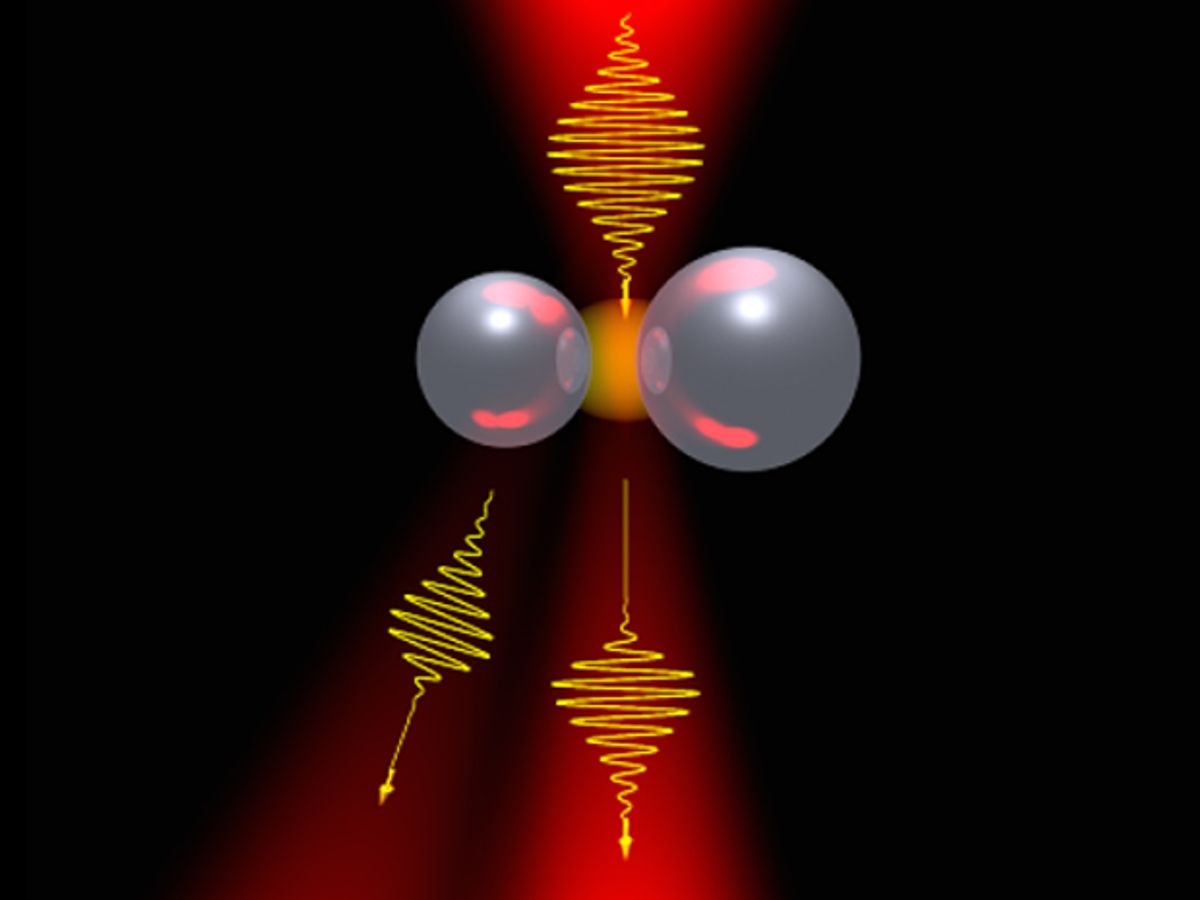Russian and U.S. researchers have developed a technique whereby the direction of light can be manipulated using a novel optical nanoantenna. The researchers believe that this nanoantenna could help lead to a new era in optical information processing in telecommunications systems.
Of course, replacing electrons with photons is the basis of optical computing. However, realizing this switch is fraught with difficulties—not the least of which is the fact that because a photon has neither mass nor an electric charge, it is far more difficult to steer than an electron, which can be pushed or pulled simply by applying an electric field. For optical computing to work, there needs to a control mechanism for photons that is just as simple. Waveguides are able to contain light and guide it in a certain direction over long distances. A nanoantenna works differently. Instead of guiding light, it bounces the photons that strike it in a specific direction. That directionality is determined by the materials and geometry of the nanoantenna, just like in classical antennas.
But what sets the nanoantenna developed by the research team from ITMO University in St. Petersburg, Russia, the Moscow Institute of Physics and Technology (MIPT), and the University of Texas in Austin, apart is that this photon-scattering proerty is tunable. The researchers say they can change the direction to which it scatters the incident light without changing its physical dimensions.
In the journal Laser & Photonics Reviews, the international research team described the development of a tiny (less than 200 by 200 by 500 nanometers) silicon-based nanoantenna that pushes photons in a particular direction depending on the intensity of the incoming wave of light.
“The new device will allow us to change the direction of light propagation at a much better rate compared to electronic analogues,” said Sergey Makarov, a senior researcher at ITMO University, in a press release.
As with previous research out of ITMO where researchers gained control over light scattering for optical computing, this proposed nanoantenna is built from silicon nanoparticles.
When silicon nanoparticles are subjected to laser light, they produce an electron plasma. This electron plasma in not the well-known surface plasmons we have become acquainted with in the field of plasmonics. This plasma is simply a bunch of conduction (free) electrons that are injected into the conduction band of a semiconductor when it absorbs light. They are free in a sense that they can move freely through the semiconductor (until they lose their energy and fall to the valence band from whence they originated).
“Surface plasmons are the special oscillations of these free electrons, but these oscillations may arise only when density of free electrons is quite large—and we dont have that many electrons in our situation,” explained Denis Baranov, a postgraduate student at MIPT, in an e-mail interview with IEEE Spectrum. “So, these are the same electrons that give rise to plasmons, but the density is not enough for them.”
It is this plasma excitation that serves as the mechanism for the nanoantenna to rotate the radiation pattern. Essentially, the more intense the incoming light, the greater the rotation becomes; it can change light’s direction by as much as 20-degrees.
“Once you choose specific diameters and positions of the particles and you gather them into a single antenna, then the direction of the light scattering is fixed,” says Baranov. “But, when plasma is generated within the particles (upon irradiation with a strong pulse), it changes their refractive index and, consequently, optical properties of the whole nanoantenna.”
In particular, it’s the plasma changes the direction of scattering. “Effectively, one may think of this as slightly changing the material the particles are made of: you change the material but leave the geometry unchanged—you have a different antenna with different light scattering,” added Baranov.
Also part of the nanoantenna’s design is the fact that one of the silicon nanoparticles needs to be resonant while the other is not. This is done to enhance the effect of the beam routing.
“Suppose that we have a nanoantenna composed of two identical particles. It cannot scatter light sideways; it always scatters it forward, due to symmetry,” explained Baranov.
However, when one of the particles is resonant, it experiences intense generation of plasma, while the other, non-resonant particle, does not. This provides the desired asymmetry in the behavior of the antenna.
“Now you see, that the same nanoantenna is capable of scattering light sideways or forward depending on the incident intensity,” said Baranov. “For weak pulses, there is not plasma generation, and since the antenna is not symmetric it scatters light sideways. When an intense pulse is applied, plasma is generated within the resonant particle, and the antenna becomes kind of "symmetric", so it scatters light forward.”
The optical antenna developed here can support data rates as fast as at 250 gigabits per second—a speed that could help it bridge the gulf between optical data transmission rates and electronic data processing speeds. Fiber optic cables are transmitting data at hundreds of gigabits per second but our electron-based computers can only process these signal at a fraction of those speeds.
Dexter Johnson is a contributing editor at IEEE Spectrum, with a focus on nanotechnology.



